Guidelines of Development for Public Management toward the Digital Organization for Education Support
Main Article Content
Abstract
The objectives of this research were to; 1) to identify the key indicators of components necessary for developing digital organizations in education, 2) to analyze the relationship between different elements and individuals’ digital skills, 3) to analyze the components of digital organization development in education, and 4) to propose guidelines for government management to move towards a digital organization in education. The sample included 388 personnel from various departments under the Office of the Permanent Secretary, Ministry of Education. The study employed a mixed-methods research approach, combining both quantitative and qualitative research methods. The results showed that: 1) there are six elements and 30 indicators essential for the development of digital organizations in education, according to the sample group, who believed these indicators to be the most important. There were 10 characteristics required for the development of digital organizations in education. 2) The relationship between personnel’s digital skills and all six digital organizational elements was found to be at a very low level of correlation. 3) All six components and 30 indicators collectively explained the variability in the development of digital educational organizations. The index of consistency with empirical data comprised of X2 =1039.415, df = 558, X2/ df = 1.863, P-value = 0.368, CFI = 0.953, TLI = 0.965, RMSEA = 0.054, SRMR = 0.061. 4) The Office of the Permanent Secretary, Ministry of Education, shall follow the criteria for personnel development, policy reform, and leveraging technology.
Article Details

This work is licensed under a Creative Commons Attribution-NonCommercial-NoDerivatives 4.0 International License.
References
ธานินทร์ อินทรวิเศษ, ธนวัฒน์ เจริญษา, และพิชญาภา ยวงสร้อย. (2564). ภาพสะท้อนการศึกษาไทยหลังภาวะโควิด 2019. วารสารการบริหารนิติบุคคลและนวัตกรรมท้องถิ่น, 7(4), 323-333.
ธีร์ ภวังคนันท์. (2564). การบริหารการศึกษาในสถานการณ์การระบาดของโรคโควิด-19 ในยุคฐานวิถีชีวิตใหม่. วารสารบวรสหการศึกษาและมนุษยสังคมศาสตร์, 2(2), 25-32.
วัยวุฒิ บุญลอย, ธีรังกูร วรบำรุงกุล, มนตรี วิชัยวงษ์, และเริงวิชญ์ นิลโคตร. (2564). โควิด-19 กับการเปลี่ยนแปลงทางการศึกษาและสังคม. ศึกษาศาสตร์สาร, 5(1), 44-57.
สถาบันพัฒนาข้าราชการพลเรือน. (2560). ทักษะด้านดิจิทัลของข้าราชการและบุคลากรภาครัฐเพื่อการปรับเปลี่ยนเป็นรัฐบาลดิจิทัล. สำนักงานข้าราชการพลเรือน.
สุรพงษ์ มาลี. (2562). การพลิกโฉมสู่องค์กรที่พร้อมปรับเปลี่ยนในยุคกำรเปลี่ยนแปลงที่พลิกผัน: โครงสร้าง ระบบ ทรัพยากรบุคคล และภาวะผู้นำ. OCSC e-Journal, 61(2), 8-11.
Comrey, A.L., & Lee, H.B. (1992). A first course in factor analysis. (2ed). Lawrence Erlbaum Associated.
Autodesk Inc (ADSK). (2021, January 25). About digital skills foundation: Digital skills foundation. https://www.digitalskillsfoundation.org/about-digital-skills-foundation/
Hair, J.F., Black, W.C., Babin, B.J., & Anderson, R.E. (2010). Multivariate data analysis (7th ed.). Pearson.
Hooper, D., Coughlan, J., & Mullen, M. R. (2008). Structural equation modeling: Guidelines for determining model fit. Journal of Business Research, 6(1), 53-60.
World Economic Forum. (2011). The future of government: Lessons Learned from around the World. https://www.alejandrobarros.com/wp-content/uploads/old/WEF_EU11_FutureofGovernment_Report-1.pdf


